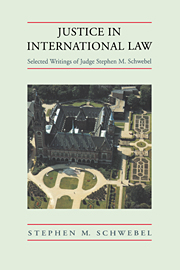Book contents
- Frontmatter
- Contents
- Preface
- PART I International Court of Justice
- PART II International Arbitration
- PART III United Nations
- 15 The Origins and Development of Article 99 of the Charter
- 16 The International Character of the Secretariat of the United Nations
- 17 Secretary-General and Secretariat
- 18 A United Nations “Guard” and a United Nations “Legion”
- 19 Mini-States and a More Effective United Nations
- 20 Article 19 of the Charter of the United Nations: Memorandum of Law
- 21 The United States Assaults the ILO
- 22 Goldberg Variations
- PART IV International Contracts and Expropriation
- PART V Aggression under, Compliance with, and Development of International Law
- List of publications
- Index
15 - The Origins and Development of Article 99 of the Charter
Published online by Cambridge University Press: 06 November 2009
- Frontmatter
- Contents
- Preface
- PART I International Court of Justice
- PART II International Arbitration
- PART III United Nations
- 15 The Origins and Development of Article 99 of the Charter
- 16 The International Character of the Secretariat of the United Nations
- 17 Secretary-General and Secretariat
- 18 A United Nations “Guard” and a United Nations “Legion”
- 19 Mini-States and a More Effective United Nations
- 20 Article 19 of the Charter of the United Nations: Memorandum of Law
- 21 The United States Assaults the ILO
- 22 Goldberg Variations
- PART IV International Contracts and Expropriation
- PART V Aggression under, Compliance with, and Development of International Law
- List of publications
- Index
Summary
Article 99 of the Charter of the United Nations, which provides that “the Secretary-General may bring to the attention of the Security Council any matter which in his opinion may threaten the maintenance of international peace and security,” was described by the Preparatory Commission of the United Nations as endowing the Secretary-General with “a quite special right which goes beyond any power previously accorded to the head of an international organization.” This description is perhaps slightly exaggerated as it fails to take account of resolutions of the First and Second Assemblies of the League of Nations which entrusted the League Secretary-General with powers of a nature remarkably similar to those with which the United Nations Secretary-General is invested by Article 99. But the words of the Preparatory Commission aptly emphasize that, with respect to the express constitutional position of the Secretary-General of the international political organization, Article 99 represents a departure of consequence.
The substance of Article 99 is not to be found in the Covenant. While in the early drafts of the Covenant powers were to have been allotted to the Secretary-General which may be said to have approached those later given to the Secretary-General of the United Nations, the text of the treaty which finally emerged from the Paris negotiations provided in its analogous article merely that, in case of war or threat of war, “the Secretary-General shall on the request of any Member of the League forth with summon a meeting of the Council.”
- Type
- Chapter
- Information
- Justice in International LawSelected Writings, pp. 233 - 247Publisher: Cambridge University PressPrint publication year: 1994



